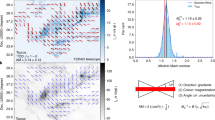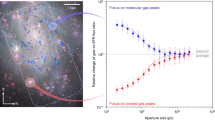Abstract
Understanding star formation rates (SFRs) is a central goal of modern star formation models, which mainly involve gravity, turbulence and, in some cases, magnetic fields (B-fields)1,2. However, a connection between B-fields and SFRs has never been observed. Here, a comparison between the surveys of SFRs3,4 and a study of cloud–field alignment5—which revealed a bimodal (parallel or perpendicular) alignment—shows consistently lower SFRs per solar mass for clouds almost perpendicular to the B-fields. This is evidence of B-fields being a primary regulator of SFRs. The perpendicular alignment possesses a significantly higher magnetic flux than the parallel alignment and thus a stronger support of the gas against self-gravity. This results in overall lower masses of the fragmented components, which are in agreement with lower SFRs.
This is a preview of subscription content, access via your institution
Access options
Access Nature and 54 other Nature Portfolio journals
Get Nature+, our best-value online-access subscription
$29.99 / 30 days
cancel any time
Subscribe to this journal
Receive 12 digital issues and online access to articles
$119.00 per year
only $9.92 per issue
Buy this article
- Purchase on Springer Link
- Instant access to full article PDF
Prices may be subject to local taxes which are calculated during checkout



Similar content being viewed by others
References
Padoan, P . et al. in Protostars and Planets VI (eds Beuther, H., Klessen, R., Dullemond, C. & Henning, T. ) 77–100 (Univ. Arizona Press, 2014).
Federrath, C. & Klessen, R. The star formation rate of turbulent magnetized clouds: comparing theory, simulations, and observations. Astrophys. J. 761, 156–187 (2012).
Heiderman, A., Evans, N. J. II, Allen, L., Huard, T. & Heyer, M. The star formation rate and gas surface density relation in the Milky Way: implications for extragalactic studies. Astrophys. J. 723, 1019–1037 (2010).
Lada, C., Lombardi, M. & Alves, J. On the star formation rates in molecular clouds. Astrophys. J. 724, 687–693 (2010).
Li, H.-B., Fang, M., Henning, T. & Kainulainen, J. The link between magnetic fields and filamentary clouds: bimodal cloud orientations in the Gould Belt. Mon. Not. R. Astron. Soc. 436, 3707–3719 (2013).
Krumholz, M., Dekel, A. & McKee, C. A universal, local star formation law in galactic clouds, nearby galaxies, high-redshift disks, and starbursts. Astrophys. J. 745, 69 (2012).
Lada, C. Star formation in the galaxy: an observational overview. Prog. Theor. Phys. Supplement. 158, 1–23 (2005).
Federrath, C. Inefficient star formation through turbulence, magnetic fields and feedback. Mon. Not. R. Astron. Soc. 450, 4035–4042 (2015).
Heyer, M., Williams, J. & Brunt, C. Turbulent gas flows in the Rosette and G216-2.5 molecular clouds: assessing turbulent fragmentation descriptions of star formation. Astrophys. J. 643, 956–964 (2006).
Li, H.-b. et al. in Protostars and Planets VI (eds Beuther, H., Klessen, R., Dullemond, C. & Henning, T. ) 101–123 (Univ. Arizona Press, 2014).
Crutcher, R., Wandelt, B., Heiles, C., Falgarone, E. & Troland, T. Magnetic fields in interstellar clouds from Zeeman observations: inference of total field strengths by Bayesian analysis. Astrophys. J. 725, 466–479 (2010).
Li, H.-b., Dowell, C. D., Goodman, A., Hildebrand, R. & Novak, G. Anchoring magnetic field in turbulent molecular clouds. Astrophys. J. 704, 891–897 (2009).
Li, H.-b. et al. Self-similar fragmentation regulated by magnetic fields in a region forming massive stars. Nature 520, 518–521 (2015).
Arzoumanian, D. et al. Characterizing interstellar filaments with Herschel in IC 5146. Astron. Astrophys. 529, L6–L14 (2011).
Gutermuth, R. et al. A Spitzer survey of young stellar clusters within one kiloparsec of the Sun: cluster core extraction and basic structural analysis. Astrophys. J. 184, 18–83 (2009).
Stutz, A. & Gould, A. Slingshot mechanism in Orion: kinematic evidence for ejection of protostars by fliaments. Astron. Astrophys. 590, A2–A15 (2016).
Otto, F., Ji, W. & Li, H.-b. Velocity anisotropy in self-gravitating molecular clouds. I. simulation. Astrophys. J. 836, 95–108 (2017).
Li, P. S., McKee, C. F. & Klein, R. I. Magnetized interstellar molecular clouds—I. Comparison between simulations and Zeeman observations. Mon. Not. R. Astron. Soc. 452, 2500–2527 (2015).
Mestel, L. & Quart. J. R. Problems of star formation—II. Q. J. Roy. Astron. Soc. 6, 265–298 (1965).
Strittmatter, P. A. Gravitational collapse in the presence of a magnetic field. Mon. Not. R. Astron. Soc. 132, 359–378 (1966).
Kauffmann, J., Pillai, T., Shetty, R., Myers, P. & Goodman, A. The mass–size relation from clouds to cores. II. Solar neighborhood clouds. Astrophys. J. 716, 433–445 (2010).
Crutcher, R., Hakobian, N. & Troland, T. Testing magnetic star formation theory. Astrophys. J. 692, 844–855 (2009).
Mouschovias, T. & Tassis, K. Testing molecular-cloud fragmentation theories: self-consistent analysis of OH Zeeman observations. Mon. Not. R. Astron. Soc. 400, L15–L19 (2009).
Bertram, E., Federrath, C., Banerjee, R. & Klessen, R. S. Statistical analysis of the mass-to-flux ratio in turbulent cores: effects of magnetic field reversals and dynamo amplification. Mon. Not. R. Astron. Soc. 420, 3163–3173 (2012).
Lazarian, A., Esquivel, A. & Crutcher, R. Magnetization of cloud cores and envelopes and other observational consequences of reconnection diffusion. Astrophys. J. 757, 154 (2012).
Crutcher, R. Magnetic fields in molecular clouds. Annu. Rev. Astron. Astrophys. 50, 29–63 (2012).
Klein, R. I., Li, P. & McKee, C. F. Multi-physics feedback simulations with realistic initial conditions of the formation of star clusters: from large scale magnetized clouds to turbulent clumps to cores to stars. Astron. Soc. Pac. Conf. Ser. 498, 91–101 (2015).
Alves, F., Franco, G. & Girart, J. M. Optical polarimetry toward the Pipe nebula: revealing the importance of the magnetic field. Astron. Astrophys. 486, L13–L16 (2008).
Heiles, C. 9286 stars: an agglomeration of stellar polarization catalogs. Astronphys. J. 119, 923–927 (2000).
Planck Collaboration Planck intermediate results: XXXV. Probing the role of the magnetic field in the formation of structure in molecular clouds. Astron. Astrophys. 586, A138–A165 (2016).
Goodman, A., Bastien, P., Myers, P. & Menard, F. Optical polarization maps of starforming regions in Perseus, Taurus, and Ophiuchus. Astrophys. J. 359, 363–377 (1990).
Li, H.-b. et al. Results of SPARO 2003: mapping magnetic fields in giant molecular clouds. Astronphys. J. 648, 340–354 (2006).
Bally, J., Walawender, J., Johnstone, D., Kirk, H. & Goodman, A. in Handbook of Star Forming Regions Vol. I (ed. Reipurth, B.) 308–345 (Astronomical Society of the Pacific Press, 2008).
Arce, H., Goodman, A., Bastien, P., Manset, N. & Sumner, M. The polarizing power of the interstellar medium in Taurus. Astronphys. J. 499, L93–L97 (1998).
Acknowledgements
The research was supported by the Hong Kong Research Grant Council, projects T12/402/13N, ECS24300314 and GRF14600915 and by the Chinese University of Hong Kong Direct Grant for Research, project 4053126 Analyzing Simulation Data of Star Formation. H.-b.L. appreciates the conference Star Formation in Different Environments 2016, where the discussion, especially with C. Matzner and J. D. Soler, inspired the direction we present in this work. Q.G. thanks Y. Wang for the discussion on Planck data analysis.
Author information
Authors and Affiliations
Contributions
H.-b.L. designed and executed the experiment. H.J. and X.F. were in charge of the statistical tests. Q.G. and Y.Z. were responsible for the Planck data analysis.
Corresponding author
Ethics declarations
Competing interests
The authors declare no competing financial interests.
Supplementary information
Supplementary Information
Supplementary Figures 1–5, Supplementary Table 1 and Supplementary References. (PDF 2452 kb)
Rights and permissions
About this article
Cite this article
Li, Hb., Jiang, H., Fan, X. et al. The link between magnetic field orientations and star formation rates. Nat Astron 1, 0158 (2017). https://doi.org/10.1038/s41550-017-0158
Received:
Accepted:
Published:
DOI: https://doi.org/10.1038/s41550-017-0158



